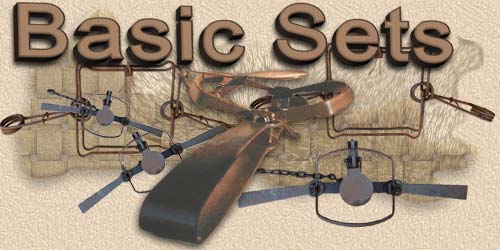| The castors and oil sacs from beavers can be valuable
to the trapper
either to sell or to use for making lure. Castors and oil sacs are not
very difficult to remove from a beaver if you know where they are
located
and how to remove them without rupturing or cutting them.
1. First, you need a beaver, as shown below. The
castors and
oil sacs are located just above the vent. Note there is no
external
evidence of the sex of this beaver.
2. Make a cut from the vent up the belly just
under the fur about
eight inches. If you are skinning the beaver for fur, you may
want
to wait until you're done skinning the beaver to remove the castors and
oil sacs. Cut shown below.
3. Peel back the fur on each side of the
cut to expose
the area where the castors and oil sacs are located. The castors
and oil glands are hidden under a thin membrane of muscle - the reddish
pink membrane is clearly visible in picture #3.
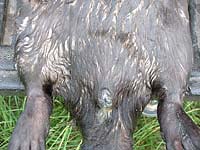 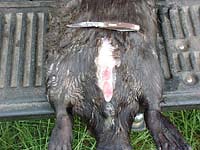 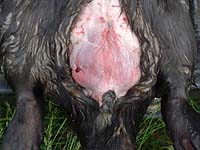
1.
2.
3.
4. Carelfully cut through the membrane and begin
peeling it away
from the castors. The castors are right below this membrane, so
care
must be taken not to cut the castors. I find that if I pinch the
membrane between my index finger and thumb, I'm able to pull the
membrane
away from the castor and safely cut through the membrane.
5. Once the membrane is cut away and pulled
back, you can
see the castors on each side. Below the castors you can see those
two pink looking tubular shaped glands. These are the oil
sacs.
Also, on this beaver you can easily see it's a male. At the upper
part between the castors, you can see the beaver's penis. A
female
will only have a thin membrane at this location.
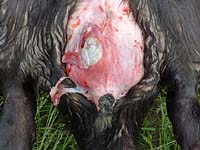 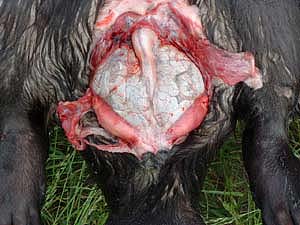
4.
5.
6. Next I gently grasp one castor with the
fingers on one
hand and with the fingers of my other hand I pull the membrane off of
the
castor and work it out. The castors need to have all the red
membrane
removed from them. The castors can be very delicate and can tear
easily if too much pressure is applied. Different castors can
take
different amounts of pulling before tearing. The best way to get
a good at this is by doing.
7. After working both castors free of the
membrane, two
cuts need to be made to free it from the beaver. The first cut is
from the penis as is shown below where the knife blade is
located.
Its the same on the female, except there is only a thin membrane to
cut.
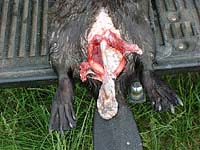 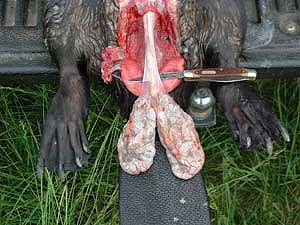
6.
7.
8. The location of the last cut to free the
castor is shown
below where the knife blade is. This cut is made where the
castors
are attached to the vent. The oil glands can be easily seen above
where this cut is to be made.
9. On the tail of the beaver is the set of
castors that
were removed. They are nice and full and will be partially dried
and ground in preparation for using them in making lure. Notice
that
there is none of the pink membrane on the castors. It's important
to make sure it is all removed.
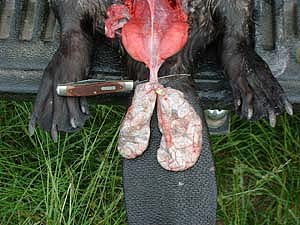 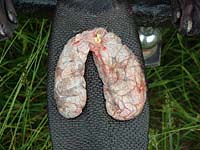
8.
9.
10. To remove the oil glands, simply cut
the mebrane around
them., then cut where they join at the vent. I like to cut them
so
they remain with membrane keeping them attached to one another.
It
is not necessary to remove the red membrane from the oil sacs if they
are
to be milked of their oil.
11. On the tail of the beaver is shown the
set of castors
and the oil glands.
12. After I have the castors and oil sacs
removed, I like
to hang them on the lip of a 5 gallon bucket that I keep in my
truck.
This begins the drying process for the castors and oil sacs. I
like
to dry both the castors and oil sacs until the outside gets a leathery
feel to it. In low humidity it takes about four or five
days.
I will then place the partially dried castors in a freezer until I have
accumulated enough to make a good batch when ground. I find that
the oil is easier to milk from the oil glands after they have
dried
that four or five days.
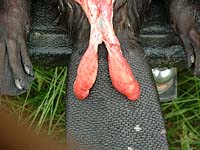 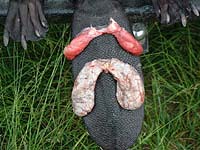 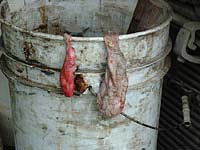
10.
11.
12.
|
